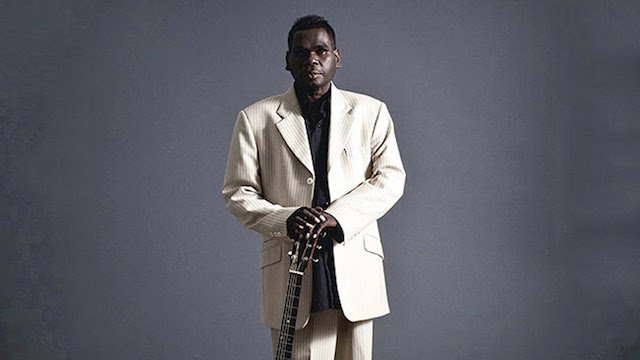When I ask what Gurrumul’s favourite movie was, Snakes On A Plane wasn’t what I was expecting to hear. Number two and three on his list was taken out by Anaconda and Anaconda 2. For Paul Damien Williams, the director of this year’s doco Gurrumul, having his own film not even rank is something he calmly accepts.
“You can’t always win in life, you just do the best you can,” he says, adding that, “to be his favourite documentary is something at least.”
This sentiment describes Gurrumul as a man and an artist, someone who always placed authenticity to himself and his people above success. Born blind and raised in the remote community on Elcho Island in northeast Arnhem Land, Geoffrey Gurrumul Yunipingu was blessed with a preternatural talent for music, teaching himself to play guitar while still a small child. Finding a joy in music he could never find in the visual world, he spent his life using his talent to do his best to express his connection to his culture, his people, his land and his community.
Gurrumul passed away on the 25th Of July 2017, leaving an impressive legacy behind him. His posthumous album Djarimirri (Child Of The Rainbow) became the first Indigenous language album to top the ARIA Charts when it was released on April 12th this year, and a week later Williams’ eponymous biopic was released to critical acclaim.
With his success, came fame, and with that a difficult decision to be made about whether his name should be retired as is custom, or if it should be allowed to live on. Seen by many fans and members of his own community as a bridge between contemporary Australian culture and our often undervalued Indigenous heritage, his family and tribal elders decided that while it will always be painful for them to be reminded of his death, his legacy is too important.
“For the Yolgnu to have made the decision to keep the name alive, I don’t think it was just a rational or political thing, it was done with a lot of intent and I don’t think it was just simply pragmatic,” Michael Hohnen Gurrumul’s longtime producer and spokesperson explains.
“As I said in the film you know, if every day a new tile fell off the Opera House, and no one did anything about it, there would be outrage. Well that’s happening everyday to Indigenous culture and G’s legacy can help us bring attention to that and to help keep the language and culture alive and relevant.”
Gurrumul’s longtime musical collaborator and producer for years, Hohnen has also served as his voice to the public. Especially when it came to dealing with the media.
The songwriter rarely spoke in interviews, preferring to let his music or Hohnen speak for him. Since Gurrumul’s passing, Hohnen has continued the work of spreading his music and its message and the documentary is almost as much his story as Gurrumul’s.
Speaking for Gurrumul and for Indigenous culture is not something that came easily to Hohnen. Keenly aware of how his role and that off Mark T. Grose – Gurrumul’s manager and head of Skinnyfish Records who released his albums – may come across as exploitative to some, it took time and a lot of encouragement and support from the Elcho Island community for Hohnen to embrace the role.
“I think I first went to Elcho in 1992, and since then and over many many years I think I developed the confidence and a thicker skin,” he says, adding that “having G’s family having my back culturally and just telling me ‘no, you’re right, what you’re doing is what you’ve been charged to do and there is no one else who is doing it or who is going to do it, there’s no one who has that relationship,’ that has helped a lot. In the end we just decided that we had to stop caring about how we felt it looked and just listen to what they were telling us to do.”
Williams’ film gives audiences a direct look into this relationship, helping audiences understand the depth of the bond between the two men and the music.
While trying to tell the story of an artist who largely refuses to discuss his music would seem like an insurmountable obstacle to most filmmakers setting out to make a music biopic, Williams takes it in stride. Focussing on Gurrumul’s silence as its own statement, the result is a film that both captures the artist’s enigmatic and taciturn personality while also giving context to his art and those that helped him share it with the world.
“I think that we set that up in the film in how we structured it to begin with that interview with Sharon O’Neill from the ABC,” he explains.
“Sharon is an incredibly well prepared, well researched reporter, and she’s being a complete professional, but she comes up against this immovable force that doesn’t want to participate in what we take for granted, which is the expectations of a world he’s not particularly interested in.
“So the film is on his terms in that regard, and in a way it’s about a journey of discovery for Michael and Mark having to come to terms with the cultural requirements of a completely different world, a completely different culture and a completely different way of doing things, and they have to conform to that world more than Gurrumul has to conform to theirs. And that’s a watershed moment when Mark makes that realisation.”
This moment comes when on the eve of a huge US tour, Gurrumul simply doesn’t show up to Darwin airport. And it’s a moment in the film that divides reaction.
“The way audiences read that really depends on their point of view,” Williams explains. “Some people see Mark and Michael and being exploitative there, and some people find their distress there really really funny. But the fact is, if you cancel a massive international tour like that at the last minute and you’re a tiny tiny record label out of Darwin… it almost broke them.
“The fact that they were able to find reconciliation and to find common ground after that and to keep the relationship going, speaks volumes from both sides.”
Tracking the songwriter down back on Elcho Island, they find Gurrumul immersed in the traditional stories of his people, learning the songlines that would allow him to sing from creation to the present day. While the exact details of their reunion aren’t made explicit through the film, there is a sense that despite his music serving as a bridge between cultures, in order for Gurrumul to cross the bridge into their world, Hohnen and Grose – and audiences – must first cross fully into his.
“In any good relationship, with anyone, be it on a personal level, on a business level or on a cultural level, if you only go 50% of the way and they only go 50% of the way, you basically don’t have a deal,” Hohnen says.
The final album, Djarrimirri (Child Of The Rainbow) is certainly a testament to what can be achieved when a partnership can be formed across cultural lines. Where his earlier work combined Indigenous language and traditional music with influences from the western folk tradition and pop music – Vince Gill and The Eagles being major touchstones according to Hohnen – Djarrimirri has an altogether different approach, transcribing traditional Indigenous musical forms through minimalist classical orchestration. The result is what many are calling Australia’s most original recording ever, and its commercial and critical success speaks for itself. As does the music.
Even to those of us who don’t understand the language, Gurrumul’s music captures the sense of connection and unity he feels to his people, their land and their spirits so clearly that one can’t help but feel it too – albeit each in their own personal way. A sense of sentimentality or nostalgia finds expression here despite how unfamiliar and otherworldly the music may sound to more western attuned ears and the feeling of connection to our own ideas of land and spirit is visceral and undeniable.
For Hohnen, the album is a gift from Gurrumul and the Yolgnu people to contemporary Australia. “This is education,” he explains.
“Education is a huge part of Yolgnu culture, and they’re constantly trying to teach their culture and history to others. To share it. There are thousands of things that they try and teach you if you spend time with them and I love that.
“The Yolgnu know that if they give us this culture it not only gives them a place at the table but it also makes them more relevant because they know how beautiful it is and they want to share that beauty with everyone.
“They share it because it makes us richer,” he says. “It makes the country richer.”
For Williams this is the most important message the film has to share. “You can build a bridge but you have to walk over it, and a bridge connects two pieces of land, it spans two ideas and two different worlds.”
In this light, the focus on Hohnen in the film is not just a means of interpreting Gurrumul’s journey. Instead Hohnen and Grose serve as templates for how white Australians can navigate the nuances of working with Indigenous communities, and how to respect and share their culture while avoiding cultural appropriation and exploitation.
“Ultimately this film, from my directorial perspective is a film about reconciliation,” Williams says. “It’s a film about what happens when you build that bridge and when both sides span it together and what can be achieved culturally, politically and socially when you do that.
“So this is not a straightforward biopic. It’s really a film that focuses on the future of European and Indigenous race relations in this country and I think it is a parable for what can happen. And what Gurrumul, and Michael and Errki Veltheim have achieved with this final album is a soundtrack to that and the glorious possibilities to what is ahead.”
–
‘Djarrimirri (Child Of The Rainbow)’ is out now. ‘Gurrumul’ is in cinemas now.












